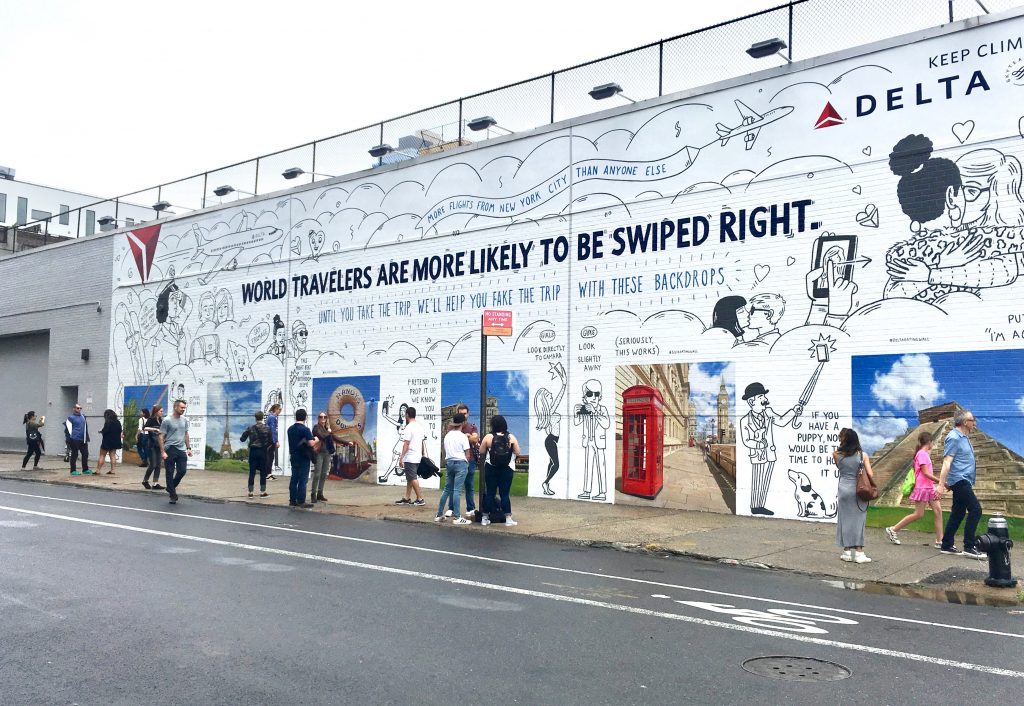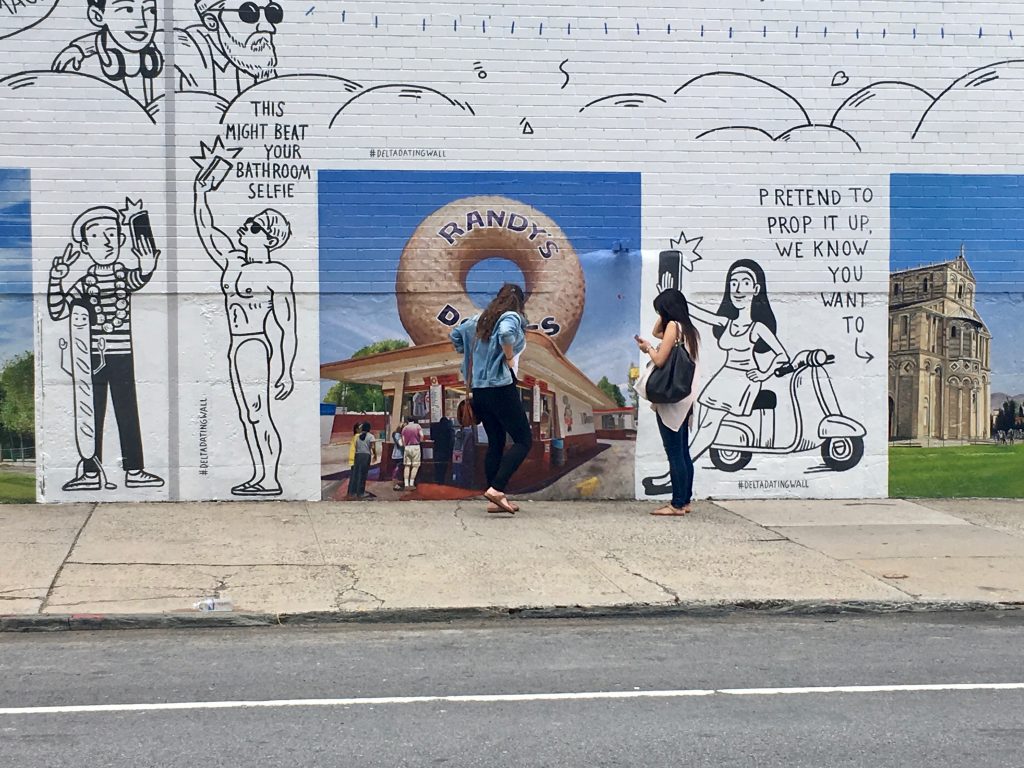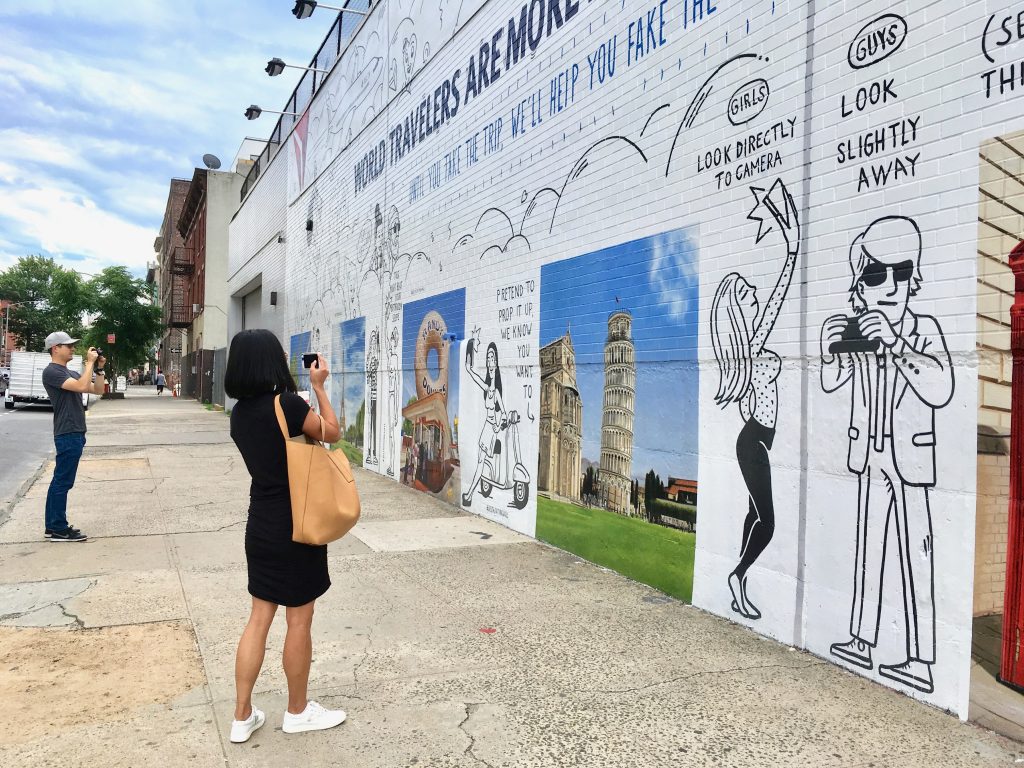Final Destination
Tinder, travel, and faking it.

On the corner of Williamsburg’s 10th and Wythe, camera flashes strike the Delta Dating Wall, a chipper summer marketing campaign courtesy of strange bedfellows Delta and Tinder. Citing industry research that suggests world travelers are more likely to receive right swipes, Delta and Tinder have jointly sponsored a two-wall mural featuring nine scenes from Delta destinations around the world. The companies’ stated hope is that people will refurbish their Tinder profiles with photos taken in front of said scenes, appear well-traveled, then find themselves swimming in right swipes.
I made my first pilgrimage to the Delta Dating Wall in June for its inaugural event. Professional photographers had been hired to take photos of people as they posed in front of painted backgrounds depicting Paris, Honolulu, Los Angeles, Pisa, London, Mexico City, Amsterdam, Moscow, and Zurich. Each vista was an anodyne idyll of its city’s most recognizable feature: the Eiffel Tower, Chichen Itzá, a crimson telephone booth. All but two were eerily bereft of other humans. The lawn across from the Eiffel Tower looked antiseptic without a single picnic; in the Amsterdam scene, a windmill was left to chaperone a field of tulips. In the two scenes that did contain people—Los Angeles (Randy’s Donuts) and Pisa (The Leaning Tower)—their bodies had been shrunken and blurred. Perhaps this feature was meant to allow the single person, in both senses of the phrase, to enjoy the spotlight without competition. But the emptiness made these traditionally animated locales look ghastly. The girl who was now smirking in front of the Leaning Tower, pretending to prop it up, seemed like a poltergeist.
“Until you take the trip, we’ll help you fake the trip,” the Wall proclaims in caffeinated script amidst enormous doodles by the illustrator Andrew Rae. The Wall itself is an exercise in ostentatious fakery. The scenes are so clearly fabricated; the bricks so clearly slathered in paint. If this is a joke about our ability to recognize artifice, are we supposed to be in on it? Could the resulting cocktail—travel FOMO spiked with relationship insecurity—really send people packing for exotic getaways, hoping to better themselves in the name of love?
![]()
I found Tiffany, 21, studying the take it-fake it slogan. Tiffany frowned. “I don’t really like that,” she said. “It’s clever, but obviously you’ll never look like the real thing. I don’t think people should capitalize on faking anything.” For some people I spoke to, profile pictures that appear too exotic are a turn-off. “If you’re in a picture with a bunch of tigers, then you’re just bragging,” said Richard, 31. A few people told me that the trouble isn’t with picking photos so much as it is deciding what to put in your bio. “Talking about yourself is hard on Tinder,” admitted Kelly, 28. “But I guess it’s hard talking about yourself in real life, too.”
On none of my visits to the Wall did I meet anyone who planned on using these photos for their profiles. The strongest endorsement was a giggly maybe. The weakest was more straightforward: “It’s just not really real.” A tourist visiting from London asked me to take a picture of her by the phone booth to send to her family as “proof” that she never left. Andy, 26, was disappointed to learn the Wall is a corporate sponsorship. “That makes it a lot less cool,” he says. “I liked it better when I thought it was just local art.”

“I’ve already been to half these places,” said Harpreet, 29, a management consultant. “I fly every other week for my job.” Last year he took 120 flights and accumulated over a million frequent flyer miles. He said he’d been on social media “from the beginning” and frequently shares photos of his travels on Facebook for his friends, who, he emphasized, enjoy his photos a great deal. Did he feel his loud social media presence was an accurate presentation of who he really was? “Ninety percent,” he said immediately. “I’m very blunt.”
“But if you’ve already got photos from all these places after visiting in person, then why are you here, taking photos that are fake?” I asked.
“It’s a great campaign,” he replied.
Harpreet stood in front of Cathedral of St. Peter the Blessed in Moscow and beamed. Then it was my turn to pose in front the storied onion domes. I wasn’t sure what sort of expression I was supposed to be making. There was too much going on, too many semantic and sociological contradictions that should not have surprised me, but did anyway: the fakery, that fakery is what people want, and that two major brands in unholy alliance have no compunction about giving it to them. On take two, I shuffled my face into an uneven grin that was meant to say a lot of things at once.
Each time I visited the Wall, I went by myself. Dating is like death, in that nobody can accompany you into the void. Successful interviews begin with some aspect of commonality, and I wanted to appear to identify with my subjects as a fellow single, Tinder-using person. My efforts proved more effective than I thought it would when a man I was interviewing tried to set me up with his friend.
“Unfortunately, I’m taken,” I said.
“No, you’re not,” he said, laughing. “I can tell by your face. No way you’re taken.”
He said he could prove it, and asked to see my phone. Feeling trapped, I showed him the front screen. It’s a photo of two of my friends in the woods, laughing. One of them is a girl with black hair, like me, and the other is a boy.
“Oh,” he said, squinting. “I guess you are.” I smiled wanly and directed the focus back to him and his friend. But my mind wouldn’t budge from his first instinct, which was correct. What in my face had he seen? What about my countenance had given away my own brand of fakery, far less picturesque than the Wall’s: the truth that I have never dated anyone, ever?
![]()
Writing in The New Inquiry, Eve Peyser and Alicia Eler liken the Tinder profile to a video game avatar. Bearing your name and modest resemblance, it skulks around a landscape that is addictive, fun, and goal-oriented. Success seems built-in: someone, somewhere, in theory, will swipe right, and it will be mutual. As in Neopets or Nintendogs, the dating avatar weakens without constant tending. Neglect the app and it will treat you accordingly, hiding your profile away until you’re ready to play once more.
When I created my Tinder profile, having lived this long without engaging in any sort of romantic relationship had come to seem like worse than a failing. It had become unbelievable, a fact so discordant with my friends’ experiences that I had begun to view it as a falsehood. One infuriated evening, I announced via text to a faraway friend that I must be cursed, another melodramatic victim of hamartia. And so my Tinder avatar had to seem realer than me. It had to prove to the Tinder community what I myself could not, and what seemed so crucial to my success on the app: that I was a normal person with a record of romantic intrigue and success.

The first profile picture I picked was of me in a short skirt, because girls in short skirts have dated. This I followed with a candid shot of me with my violin, because girls who play the violin have dated, and then a picture of myself laughing, because girls who laugh have dated. I had trouble picking a fourth photo, but I finally decided on a shot of myself leaning back in a chair and looking smug, because even girls who look smug have dated. I imagined the photographers of all these shots would be embarrassed to know I’d put their work to such desperate purposes, but common sense told me that selfies would look glib. My bio was a cheeky fragment from Anne Carson’s Autobiography of Red in which the main character, a red monster named Geryon, quips that he is a “philosopher of sandwiches,” which seemed like something I could have said.
The result wasn’t bad. I’d pulled a Pygmalion and built a girl. She looked like me, and she sounded like me even though she only said one thing, like a talking doll you activate by pulling a string. When I saw that she had actually matched with people, and that those people had actually messaged me, I laughed. I had no idea what they were liking. Her face? Her body? Her apparent race—I am half Chinese, but most people think I look white—and class? Her school? Her clothes? Her snippy little bio? Was the person swiping just swiping right on everybody? Was the person not a person at all, but a bot masquerading as a waxen European model in town only for the weekend? Was the person swiping because my avatar seemed like a person capable of dating, because she had before?
The girl I built seems to play the game pretty well. She has also changed a lot as I’ve used the app, to the extent that remembering her first version isn’t easy. She shows more skin and has replaced the Anne Carson with original material. So long as I air her out once in awhile, she will work on my behalf. She wanders around the endless high school hallway that is Tinder, leaving kissy post-its on all the artistically inclined boys’ lockers with a brazenness I could never imagine mustering in real life. She’s managed to win me some real-life dates, at least one of which was worth smiling about. She doesn’t even need me! She does just fine on her own. Sometimes I even imagine her setting herself free.
![]() I usually swipe in the early morning, when I’ve forgotten to sleep and the birds on my block are going off, always squawking too soon. I’ve started to swipe faster, and I’m missing a few. Oh, he was cute. But the app makes regret inefficient. In periods of discouragement, I begin to swipe so quickly that the faces blur into each other and become an infinite smear, like the faces are dough and my thumb is a rolling pin.
I usually swipe in the early morning, when I’ve forgotten to sleep and the birds on my block are going off, always squawking too soon. I’ve started to swipe faster, and I’m missing a few. Oh, he was cute. But the app makes regret inefficient. In periods of discouragement, I begin to swipe so quickly that the faces blur into each other and become an infinite smear, like the faces are dough and my thumb is a rolling pin.
I went to the Wall three times, in part because I hoped to more intently observe what was happening in front of it: a bemused hand-holding couple staring skyward, an unflappable man who walked by as though the Wall were a mere wall, a woman imploring her child to hold still in front of the Eiffel Tower so “Mommy can get her shot.” What I was really looking for, and did not find, was someone who had come to the Wall in all seriousness, who genuinely believed that Delta and Tinder had a point.
Except the Wall is not serious at all. The Wall is fun because pretending is fun, and it’s fun to pretend together, so long as we are all in on the joke. This is not real, and this does not matter. I play the game best when I believe this. Sometimes I swipe for so long I think I could keep swiping forever. Right, left, left, right, left, left. I swipe left on Michael (25) and Arthur (23), but right on Alex (26). I feel like I’m swiping them off the face of the earth.
Somewhere, someone is doing the same with me. The Wall’s great irony is that, after all our anxiety about appearing well-traveled, our profiles in all their grand fakery will make their way around the world, better traveled than we could ever dream of being, and meanwhile we won’t have left the couch. Our faces will stop in each other’s hands. When you do, your thumb will graze the side of my face, one of so many faces you have already grazed this night. And I will be smiling as if to ask, where will you take me next?
Jennifer Gersten is from Queens, New York. She is an assistant managing editor at Guernica and a freelance writer pursuing a master’s in violin performance.
